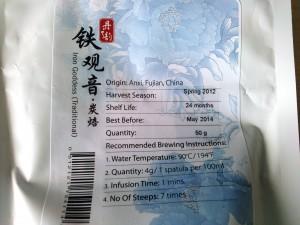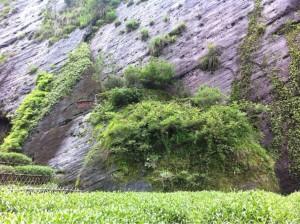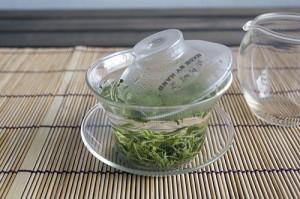As I am writing this article, I am sipping on one of my personal favorites- a Tieguanyin.
What kind, you might ask.
The traditional charcoal roasted Tieguanyin that I have in my stores, in a thinly veiled attempt at self-promotion.
But it may well be the equivalent of someone’s Guanyin Wang (观音王) aka ‘King of Guan Yin’. It might as well be someone’s “Monkey Picked Tieguanyin” or “Spring Premium Tribute Guan Yin” for those who have a flair for the dramatic.
It is only a matter of time that someone (if no one has already) goes for gusto with some fanciful “Master Wang’s Summit Grown Old Bush Spring’s First Pickings Ultra-Premium Tribute Stuff of Immortals Tieguanyin”.
*Phew- I need to take a break just typing that*
But to the point, what do product labels like this mean and do they matter?
Minimalist Approach

i) Memory retention- more words, higher propensity to forget or omit. Think this is pretty intuitive
ii) Less words means bigger font sizes and better readability on the printed product labels
iii) Less description means that the labels printed can be used for a wider range of products. i.e. Tieguanyin means I can use it for Spring and Autumn over many years- simply by pasting an extra label- as opposed to “Spring 2013 Tieguanyin” which I need to reprint next year.
With a higher print run- I can lower my per label cost.
*Note- for numerous reasons that has nothing to do with this topic, we no longer go for offset pre-printed labels so iii) is a moot point moving forward but it means iv) emerges in its wake
iv) Less words means less ink consumed
Hence when it comes to product names- it should serve a purpose- rather than adding additional fluff.
It boils down to this- it should inform the potential buyer something in regards to the quality, characteristic and market value of the product in question.
Those Monkey’s Ain’t Picked Nothing

If you look at the requirements of hand-picked Chinese tea leaves are- no purple leaves, no ‘fish leaves’ etc etc- it should be clear no simian can approach that level of competency.
Further, a commonly mentioned woe of the tea industry is that wages of pickers keep escalating, particularly in Hangzhou and Anxi (yes, home of many a ‘monkey picked’ tea). If monkeys can do the job, farmers wouldn’t be struggling with rising labor costs and lack of manpower.
Then, there’s the oft quoted saying that “monkey picked” refers to the “highest grade” which brings me to the next point….
Premium Grade?
Or you could substitute ‘superior grade’ or ‘1st grade’ among others which generally insinuates that the tea in question is of the highest grade.
While in China there’s a comprehensive grading system which covers everything from aroma to taste and appearance- unlike the British system which is only based on leaf size- enforcement is iffy, especially outside China.
Merchants can call their teas “superior grade” or anything that catches their fancy while only seasoned tea buyers can discern the difference.
For example when you look at your “superior grade” Longjing, is it entirely 1 bud to 1 leaf? That’s a basic criterion of superior grade, not to mention a host of others.
Because everyone claims their tea is of the highest possible grade, it places those who are honest at a disadvantage. True superior grade tea can cost quite a pretty penny for the most prestigious teas and most of what is commercially available is probably first or second grade or below.
Of course ‘second grade’ of anything sounds like a dirty word- although it is the 3rd highest grade out of up to 9 grades- hence most merchants would rather not label it or in some cases still go ahead and call it superior grade since there’s no penalty for labeling it as such.
So when do Labels matter?
Harvest Period
The 2 most common ones are Pre-Qing Ming (明前) and Pre-Harvest Rain (雨前). These refer to markers in the Chinese agricultural calendar around 5th April and 20th April respectively.

Of course, it’s not Pre-Qing Ming everything as it general refers to
i) Green and certain yellow teas (and not all greens benefit from ‘youth’, notably Liuan Guapian and Taiping Houkui)
ii) Grown in Jiangnan area- tea leaves grown in Yunnan (among other southern most provinces) can be quite matured even if harvested before Qing Ming
iii) Denotes something special- e.g. virtually all Silver Needles are harvested before or at least around Qing Ming, hence the label of pre-Qing Ming Silver Needles is superfluous
For more details, you can read this article.
Harvest Area
In general origin of tea is important.
But in certain cases it might be important enough to feature as the product name, or at least prominently on the label.
Take the example of Wuyi Teas:
Zhengyan (正岩), Banyan (半岩) and Zhoucha (洲茶) can have a huge bearing on the price.
For example our Wuyi Shuixian is virtual thrice the price of our Wuyi Rougui because the former is Zhengyan and the latter is not. (more on this topic here)
Or Shifeng Longjing, though technically it is part of ‘Xihu’, Shifeng Longjing is worth much more than Meijiawu for example. (For more on the geography of Longjing read this)
Production Method
For example: Tieguanyin can be green style, charcoal roasted or the ‘dark roast’, the difference between the first and the next two can be akin to entirely different varieties of teas.
Those who sworn off Tieguanyin because of the green style might be inclined to give it another shot if they knew what they were trying were the traditional versions.
Others
Then there are labels that actually make a difference but are often so abused that I often wonder if they mean anything anymore but that is a story for the next post.
See other articles on Selection and Storage of Tea
